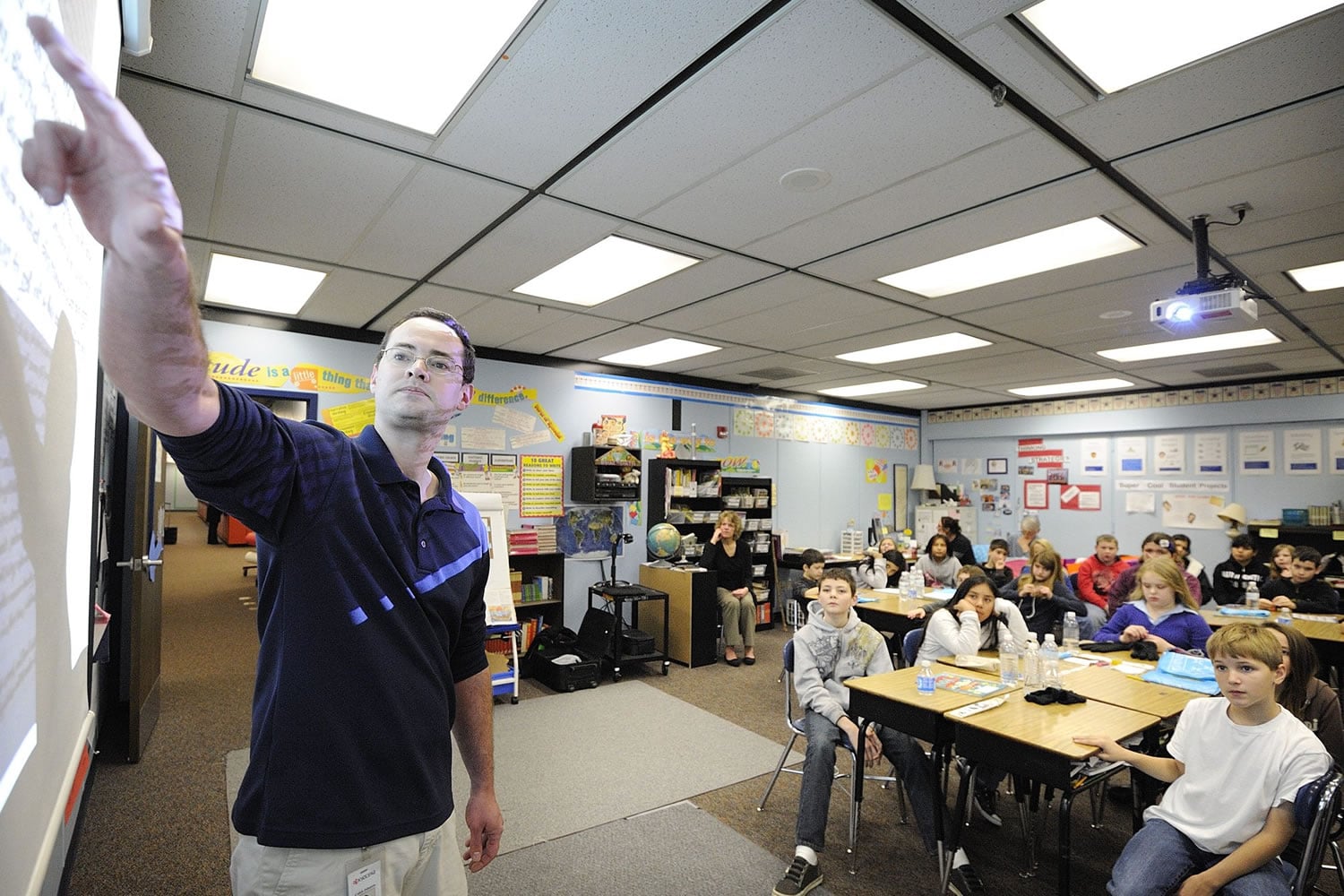One of Caleb Johnson’s books (“Here Shall I Die Ashore”) is the biography of Stephen Hopkins, who witnessed the famine and abandonment of Jamestown Colony, and then returned to America on the Mayflower with the pilgrims.
The original Thanksgiving Day celebrants wouldn’t think much of our modern holiday festivities.
It’s not that those organic eaters would turn up their noses at canned cranberries, heat-’n’-serve rolls or that green-pea salad with those little cubes of Velveeta.
The pilgrims would turn up their noses at the notion of a Thanksgiving holiday.
That was one of the historical notes Caleb Johnson, a Vancouver authority on the pilgrims, shared a few days ago with students at Sunset Elementary School.
The author has traced his family tree back to 13 different Mayflower passengers, so he has an understandable interest in the story of the pilgrims.
But as a researcher and historian, Johnson is passionate about telling that story accurately. That’s why his visit to Sunset Elementary included a closer look at the students’ history textbook, where Johnson found a few “facts” that weren’t factual at all.
The pilgrims did not land at Plymouth Rock because they were blown off course on the way to Virginia; in those days, Virginia stretched north almost to New England.
The pilgrims did not name their
colony after the city in England they sailed from; the New World town of Plymouth was already there when the Mayflower arrived in 1620.
Squanto, one of the tribal participants in the first Thanksgiving, did not return home to find all of his fellow Pawtucket Indians wiped out by disease; Squanto wasn’t a Pawtucket.
And those were just a few of the errors Johnson found in the three pages the textbook devoted to the story of the pilgrims.
Johnson’s presentation was part of a wider classroom activity involving research, primary sources and the meandering flow of information over the centuries.
Primary goal
As a records researcher, Johnson said his hobby is finding new things in primary source records. (And with a job at Kyocera Industrial Ceramics, he said, “It is only a hobby.”)
“I work with church records, court records, town records, land records, manorial records, Admiralty records, customs books, militia records, manuscripts, letters: whatever I can manage to track down that relates in some way to the Mayflower and the pilgrims that has not been previously published,” he said.
Johnson told the students about the life cycle of research. New discoveries in primary sources get published in scholarly journals, then get compiled into scholarly books, which are then used as sources by historians creating general histories. Eventually, it is processed into history books for children.
With so many steps between the original source and a grade-school textbook, “Each generation can introduce an error,” Johnson said. And, the narrative can get “enhanced” when the author exercises his imagination to toss in some details.
Johnson proved his point by showing material taken directly from primary sources. Johnson has edited several compilations of primary sources, including an 1,173-page collection of everything the pilgrims were known to have written. He showed the students a few photocopied images of original letters and journal entries to let the pilgrims speak for themselves.
“The primary sources say the pilgrims were headed for Virginia, which many people assume was hundreds of miles from Plymouth, so many histories incorrectly assume the pilgrims were blown far off course by storms. That is the impression the textbook left, as well,” Johnson said. “In fact, the border of Virginia at that time extended all the way up into modern-day New York.”
Johnson displayed an account written by pilgrim leader William Bradford, in his original handwriting, to show they intended to settle around the Hudson River near modern-day Long Island, N.Y. It was within the bounds of Virginia at the time, so they were not nearly as far off as often presented, Johnson said.
Plymouth on the map
The textbook said they named their colony after the English city they sailed from.
Johnson displayed a primary source, Capt. John Smith’s map of 1614, to show that Plymouth had already been named and labeled on a map six years before the pilgrims arrived. Then Johnson displayed another primary source, an inventory of everything religious leader William Brewster owned when he died in 1644. He owned Smith’s book — “Description of New England” — in which that map was published.
And Squanto’s disease-stricken Pawtucket tribesmen?
“The Pawtucket were an entirely unrelated Indian group far to the northeast of Plymouth,” Johnson said. “Squanto was from the Patuxet, part of the Wampanoag confederation.”
Johnson displayed a page from a 1622 journal listing Squanto’s actual tribe.
The centuries-old journals also showed that the pilgrims set aside three days for feasting and recreation, not just a day.
Because of harvest references, the pilgrims’ Thanksgiving most likely occurred in September or October, not November as the history text indicated.
Johnson also displayed images of the only two first-hand accounts of the pilgrims’ Thanksgiving. They showed that the textbook’s authors wrote a little historical fiction to add some drama, Johnson said.
Johnson also explained that the pilgrims certainly were not carving out a new holiday on the calendar; they just wanted to celebrate a good harvest.
“They didn’t believe in holidays,” Johnson said. “They were worried it would interfere with the Sabbath. The pilgrims would not have celebrated Thanksgiving.”
Tom Vogt: 360-735-4558; http://www.twitter.com/col_history;“>www.twitter.com/col_history;”>http://www.twitter.com/col_history; tom.vogt@columbian.com.




